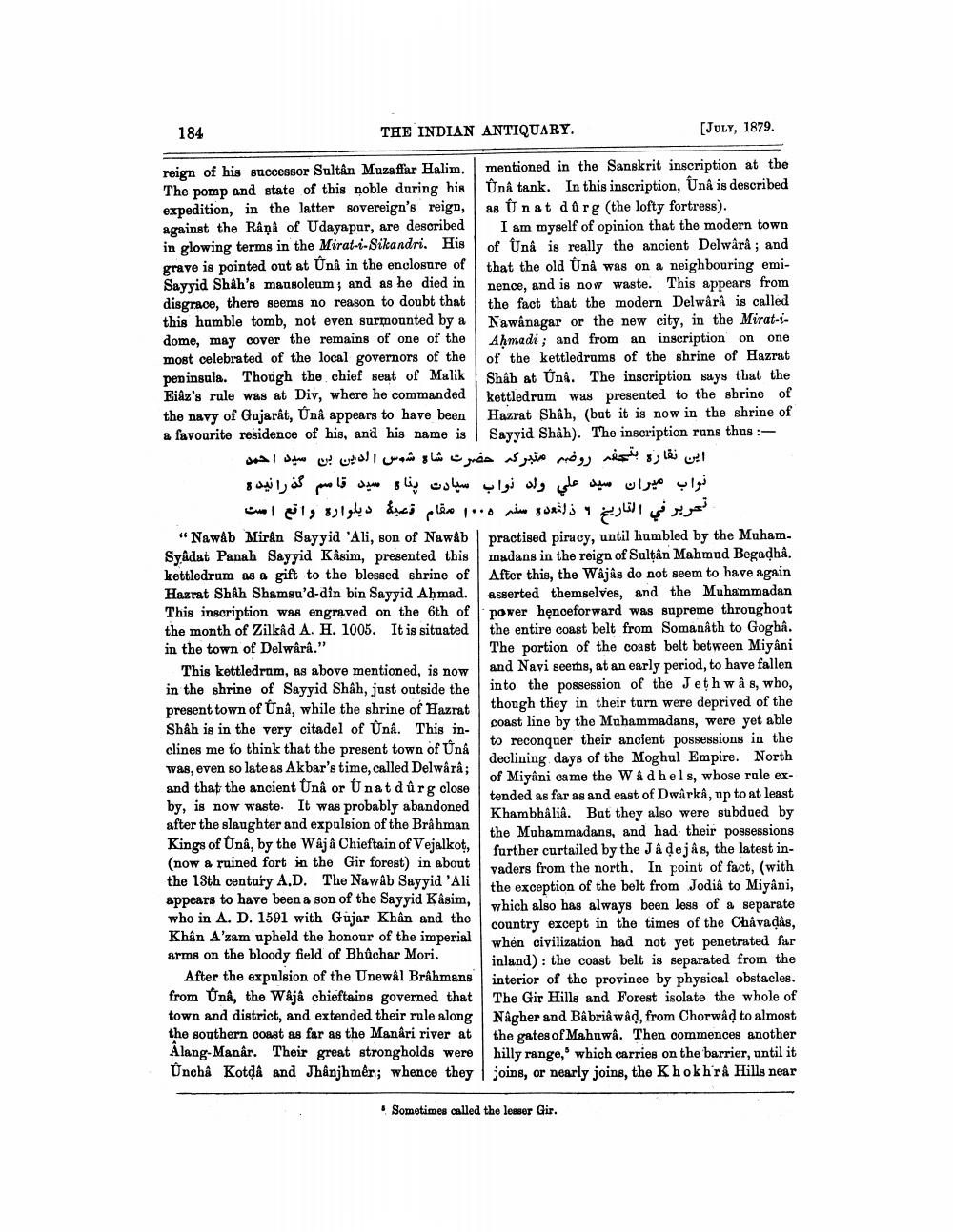________________
184
THE INDIAN ANTIQUARY.
reign of his successor Sultan Muzaffar Halim. The pomp and state of this noble during his expedition, in the latter sovereign's reign, against the Rânâ of Udayapur, are described in glowing terms in the Mirat-i-Sikandri. His grave is pointed out at Ûnâ in the enclosure of Sayyid Shah's mausoleum; and as he died in disgrace, there seems no reason to doubt that this humble tomb, not even surmounted by a dome, may cover the remains of one of the most celebrated of the local governors of the peninsula. Though the chief seat of Malik Eiâz's rule was at Div, where he commanded the navy of Gujarât, Únâ appears to have been a favourite residence of his, and his name is
این نقاره بتحفہ روضہ متبرکہ حضرت شاہ شمس الدين بن سید احمد نواب ميران سيد علي ولد نواب سیادت پناه سید قاسم گذرانید و تحرير في التاريخ 6 ذ العدة سفر ۱۰۰۰ مقام قصبه دیواره واقع است
1000
"Nawab Mirân Sayyid 'Ali, son of Nawab Syâdat Panah Sayyid Kâsim, presented this kettledrum as a gift to the blessed shrine of Hazrat Shah Shamsu'd-din bin Sayyid Ahmad. This inscription was engraved on the 6th of the month of Zilkâd A. H. 1005. It is situated in the town of Delwârâ."
[JULY, 1879. mentioned in the Sanskrit inscription at the Unâ tank. In this inscription, Unâ is described as Unat dûrg (the lofty fortress).
I am myself of opinion that the modern town of Unâ is really the ancient Delwârâ; and that the old Unâ was on a neighbouring eminence, and is now waste. This appears from the fact that the modern Delwârâ is called Nawânagar or the new city, in the Mirat-iAhmadi; and from an inscription on one of the kettledrums of the shrine of Hazrat Shah at Uni. The inscription says that the kettledrum was presented to the shrine of Hazrat Shah, (but it is now in the shrine of Sayyid Shâh). The inscription runs thus:
This kettledram, as above mentioned, is now
in the shrine of Sayyid Shâh, just outside the present town of Unâ, while the shrine of Hazrat Shâh is in the very citadel of Unâ. This inclines me to think that the present town of Unâ was, even so late as Akbar's time, called Delwårå; and that the ancient Unâ or Unat dûrg close by, is now waste. It was probably abandoned after the slaughter and expulsion of the Brahman Kings of Unâ, by the Wâj â Chieftain of Vejalkot, (now a ruined fort in the Gir forest) in about the 13th century A.D. The Nawab Sayyid 'Ali appears to have been a son of the Sayyid Kasim, who in A. D. 1591 with Gujar Khân and the Khân A'zam upheld the honour of the imperial arms on the bloody field of Bhuchar Mori.
After the expulsion of the Unewâl Brahmans from Unâ, the Wâjâ chieftains governed that town and district, and extended their rule along
the southern coast as far as the Manâri river at
Alang-Manâr. Their great strongholds were Uncha Kotḍâ and Jhanjhmêr; whence they
practised piracy, until humbled by the Muham. madans in the reign of Sultan Mahmud Begaḍhâ. After this, the Wâjâs do not seem to have again asserted themselves, and the Muhammadan power henceforward was supreme throughout the entire coast belt from Somanâth to Goghâ. The portion of the coast belt between Miyâni and Navi seems, at an early period, to have fallen into the possession of the Jeth wâs, who, though they in their turn were deprived of the coast line by the Muhammadans, were yet able to reconquer their ancient possessions in the declining days of the Moghul Empire. North of Miyâni came the Wâd hels, whose rule extended as far as and east of Dwarka, up to at least Khambhâliâ. But they also were subdued by the Muhammadans, and had their possessions further curtailed by the J â dejâs, the latest invaders from the north. In point of fact, (with the exception of the belt from Jodiâ to Miyâni, which also has always been less of a separate country except in the times of the Chavadas, when civilization had not yet penetrated far inland) the coast belt is separated from the interior of the province by physical obstacles. The Gir Hills and Forest isolate the whole of Nagher and Bâbriâwâd, from Chorwâd to almost the gates of Mahuwâ. Then commences another hilly range, which carries on the barrier, until it joins, or nearly joins, the Khokhra Hills near
⚫ Sometimes called the lesser Gir.




